Managing fatigue work and rest requirements under Daylight Saving Time
Managing fatigue work and rest requirements under Daylight Saving Time
National
Heavy
Vehicle
Regulator
What is Daylight Saving Time (DST)?
Daylight Saving Time (DST) is the practice of setting clocks forward by one hour during the warmer months to extend evening daylight. This means that clocks are typically set forward one hour in the spring (“spring forward”) and set back one hour in the autumn/fall (“fall back”).
Terms used for time zones in Australia are:
- Australian Western Standard Time (AWST) - UTC+8 - (for example, Perth, no DST)
- Australian Central Western Standard Time (ACWST) - UTC+8:45 - (for example, Eucla, no DST)
- Australian Central Standard Time (ACST) - UTC+9:30 - (for example, Darwin, no DST)
- Australian Eastern Standard Time (AEST) - UTC+10 - (for example, Brisbane, no DST)
- Australian Central Daylight Time (ACDT) - UTC+9:30/10:30 - (for example, Adelaide has DST)
- Australian Eastern Daylight Time (AEDT) - UTC+10/11 - (for example, Sydney has DST)
When does DST begin and end?
DST begins at 2am on the first Sunday in October when clocks are put forward one hour.
DST ends at 2am (3am DST) on the first Sunday in April when clocks are put back one hour.
You can check this year’s DST at: https://www.timeanddate.com/time/change/australia
Where in Australia does DST apply?
Australia has six different time zones. DST is observed in the following Australian states and territories: Australian Capital Territory (ACT), New South Wales (NSW), South Australia (SA), Tasmania (TAS), and Victoria (VIC).
The table below shows the differences across Australian states and territories during DST from 5 October 2025 to 5 April 2026.
| State/territory | Time | Difference from AEDT @ 12:00pm |
|---|---|---|
| Queensland | 11:00am | (AEST) 1 hour behind |
| South Australia | 11:30am | (ACDT) 30 minutes behind |
| Northern Territory | 10:30am | (ACST) 1 hour 30 minutes behind |
| Western Australia | 9:00am | (AWST) 3 hours behind |
| New South Wales Australian Capital Territory Victoria Tasmania |
12:00pm | AEDT |
Please note that in Broken Hill, New South Wales, DST is observed differently compared to the rest of New South Wales. Broken Hill follows the same time zone as South Australia, which is Australian Central Daylight Time (ACDT) during DST.
Here’s how it works:
- During DST: Broken Hill is on ACDT, which is UTC+10:30.
- Outside DST: Broken Hill follows Australian Central Standard Time (ACST), which is UTC+9:30.
Recording time when changing time zones for DST
Written Work Diaries: (see also Work Diary)
- Drivers travelling outside their normal time zone must ensure that they count and record time, including night rests, according to the time zone of their base (the place from which they normally work, or the garage address of the vehicle).
- You need to ensure that you are counting the correct number of hours. Both work and rest time must be counted in 15-minute blocks relative to the time zone of your base. If you are working when DST starts or ends, it may appear as though you have worked under or over your hours by 1 hour (depending on which direction the clocks have moved). For more information, see counting time.
- Make a note on the page in your Work Diary where the time changes for DST. Authorised Officers are aware of DST changes. If you are pulled over for a compliance check and have made a note, you have demonstrated consideration of DST.
Example 1: Work Diary showing work/rest time recorded for AFM, with a note of the DST change in South Australia
Example 1: Driver travels in South Australia during a DST changeover.
- Kate is driving under AFM hours. She leaves her depot in Adelaide, South Australia, at 1:45am on the first Sunday in April, and drives for 4 hours, stopping in Port Augusta, South Australia, for a 15-minute break, before returning to Adelaide.
- DST ended at 3am South Australia time and the clocks went back 1 hour. This means that the clock shows 4:45am when Kate stops for her break, not 5:45am. This makes it appear as though she has only been driving for 3 hours.
- Kate records her work start time as 1:45am and her work end time as 4:45am, as this is the actual time on the clock of her base (Adelaide). Kate makes a note that a DST change has occurred, and records her actual work/rest hours.
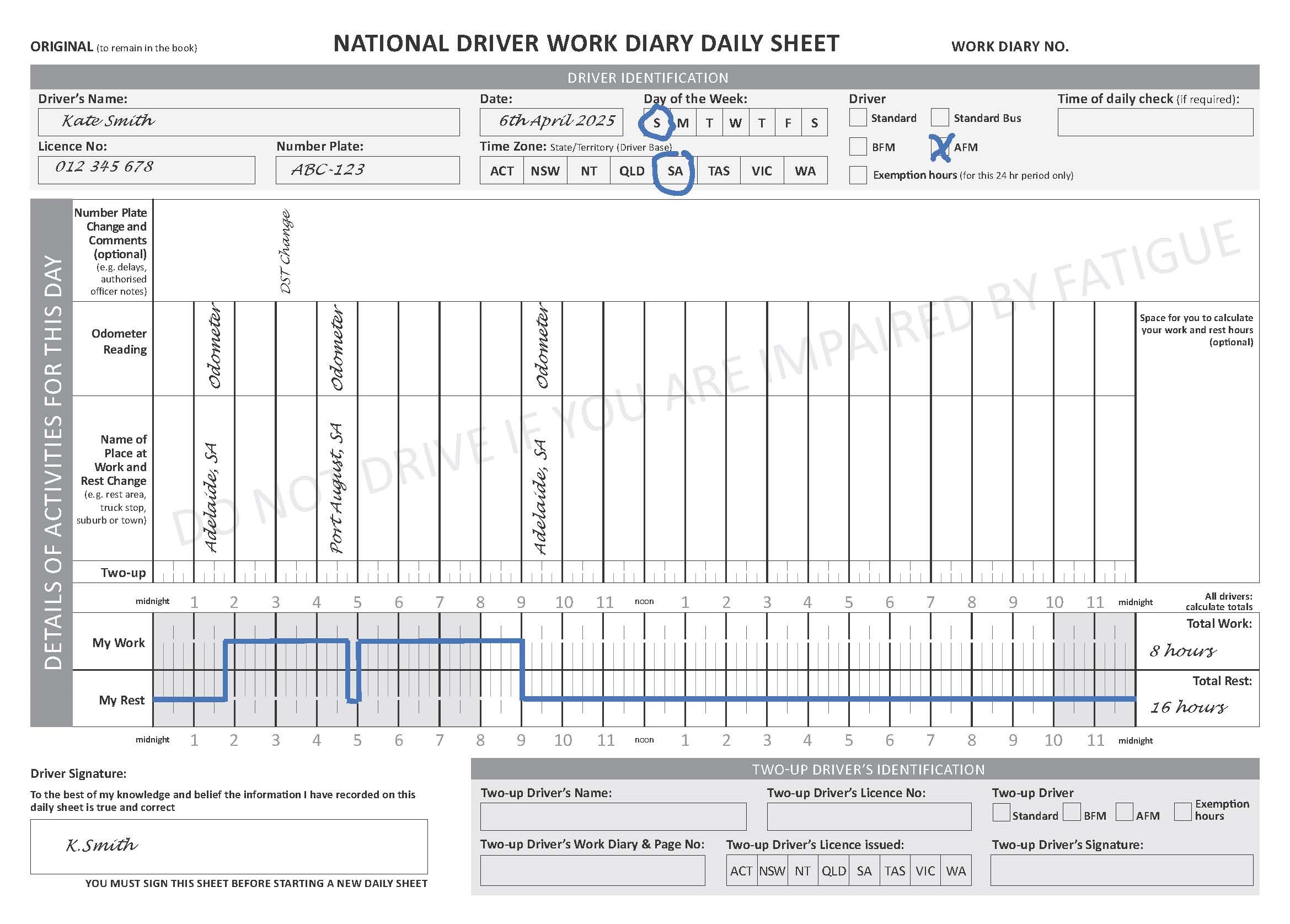
Example 2: Work Diary showing recorded entry for driving from Queensland and entering New South Wales overnight on day of DST changeover
Example 2: Driver leaves Queensland and enters New South Wales overnight on day of DST changeover.
- Suraj is driving under standard hours. He leaves Roma in Queensland at 9:30pm on the first Saturday in October and drives for 5 hours, stopping in Moree, New South Wales for a 30-minute rest break at 2:30am (Queensland time).
- DST started at 2am on Sunday morning in New South Wales, causing the clocks to move forward 1 hour. 2am in New South Wales is now 3am.
- Suraj must continue to count time relative to his base (Queensland time) and record his rest break of 30mins from 2:30am-3am, making a note in his Work Diary that he is aware it is DST changeover day.
- Suraj continues to drive from Moree, New South Wales to his destination in Dubbo, New South Wales, recording 4 hours and 30 mins work time before starting continuous rest time.
- He must continue to record time according to his base (Queensland time) and ensure that the correct number of work/rest hours are recorded.
- After completing his rest break, Suraj will continue to count his work and rest time according to his base (Queensland time) as he returns to Roma, ensuring compliance with standard hours of a solo driver.
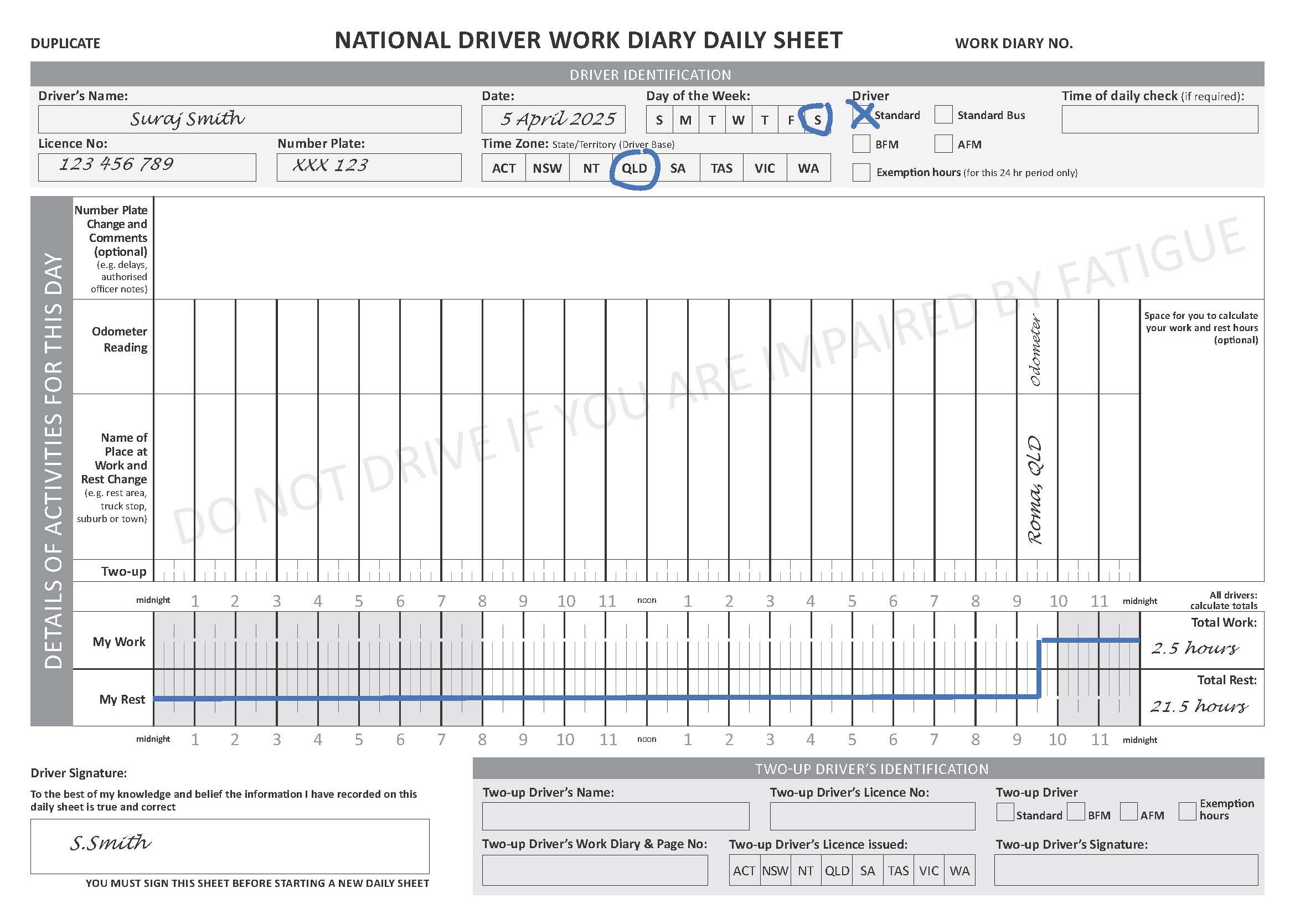
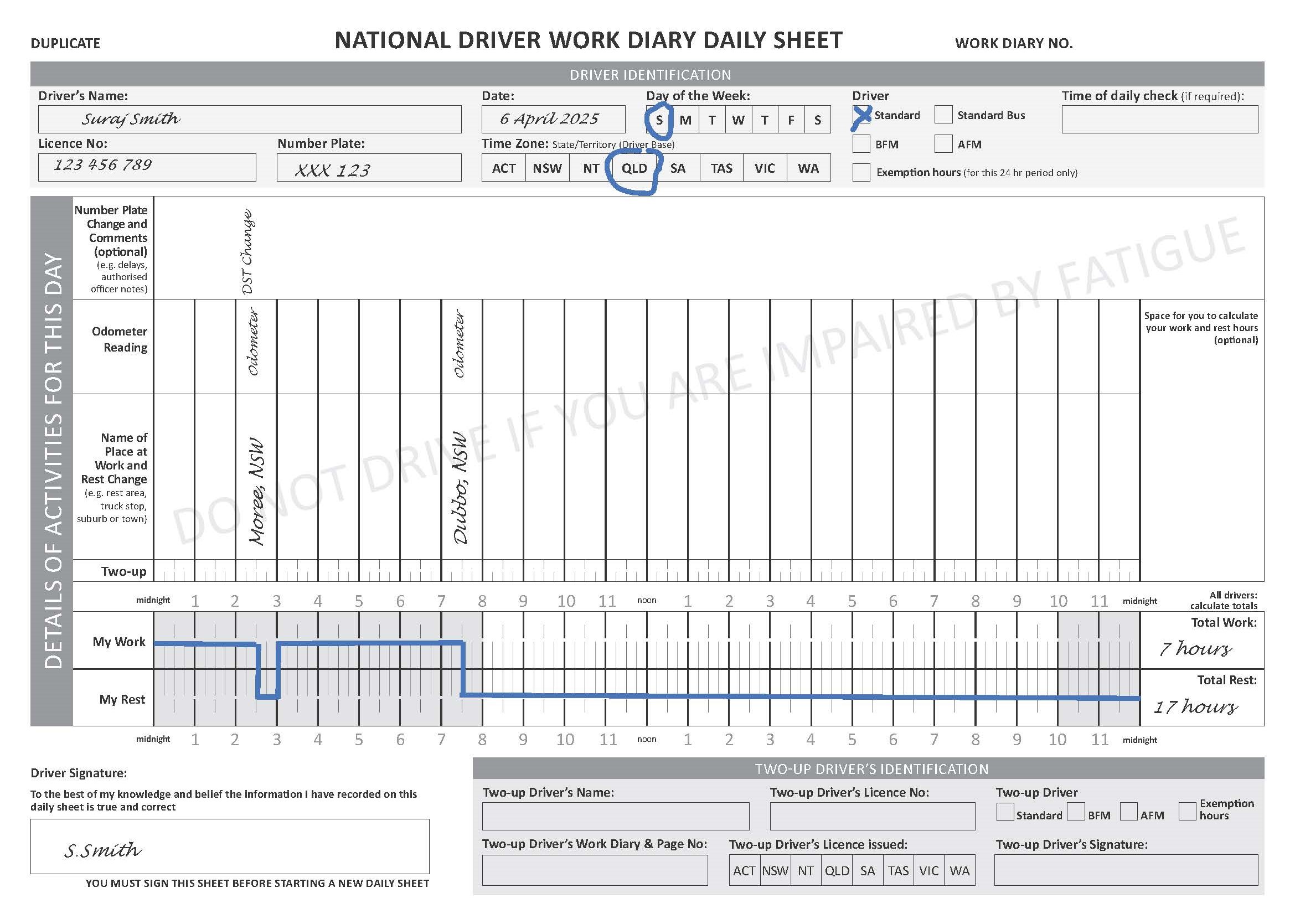
Example 3: Work Diary where a driver begins driving from New South Wales to Queensland during DST
Example 3: If you are based in New South Wales and you drive into Queensland during DST, record your work and rest hours in New South Wales time.
- Susie undertakes a round trip under standard hours from Armidale, New South Wales to Toowoomba, Queensland.
- New South Wales is currently on DST. She leaves her base at Armidale at 4.15pm and drives for 5hours to Toowoomba where she begins a rest break.
- Because of DST, the local time in Queensland is 8.15pm when Susie arrives, however the time in New South Wales is 9.15pm.
- Susie must continue to count and record time according to the time zone of her base in Armidale, which means Susie must record the change from work to rest at 9.15pm in her Work Diary in accordance with her base (New South Wales time zone). Susie should also make a note in her Work Diary that it is DST in New South Wales at this time.
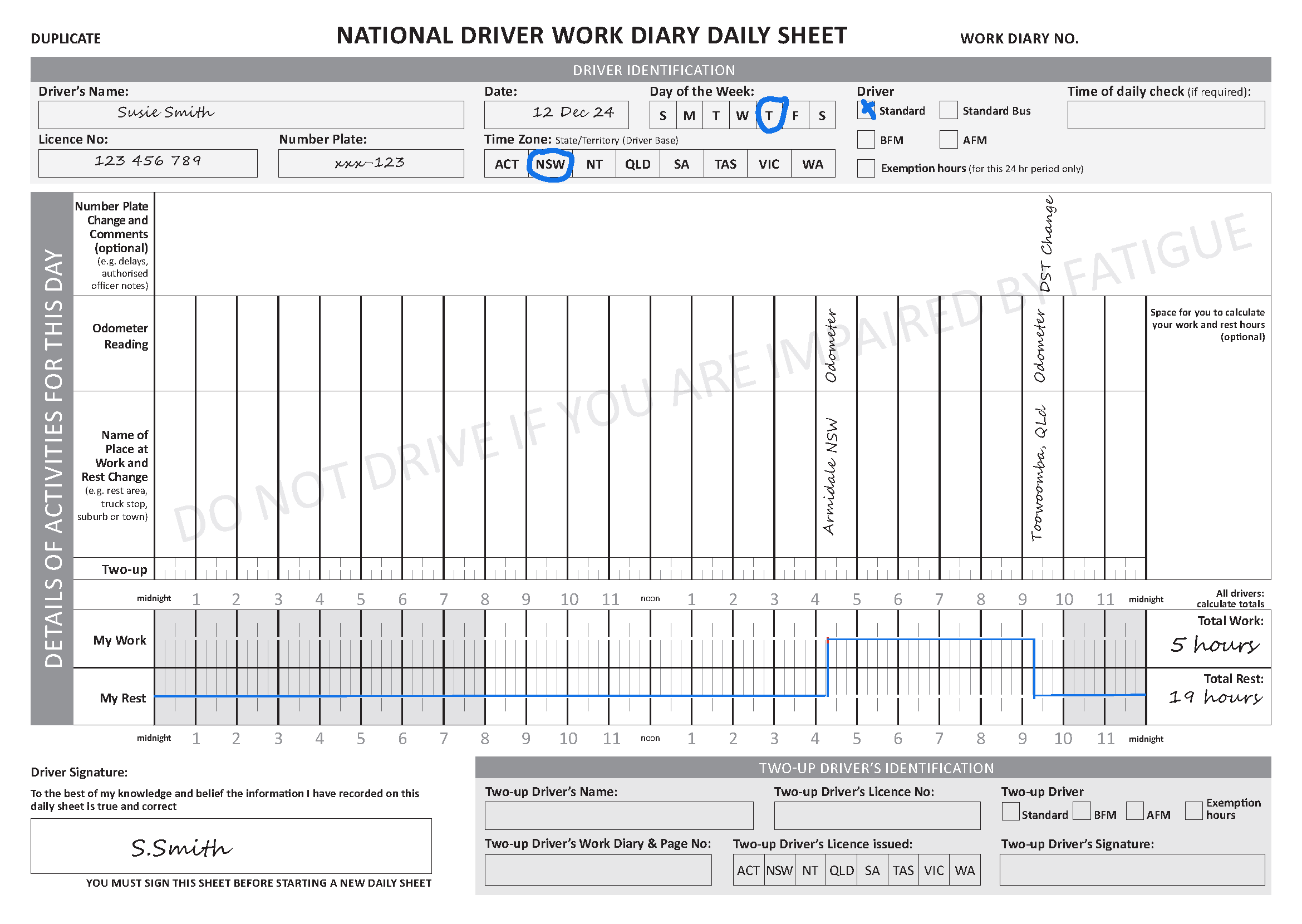
Example 4: Work Diary where a driver begins driving from Queensland to New South Wales during DST
Example 4: If you are based in Queensland and you drive into New South Wales during DST, record your work and rest hours in Queensland time.
- John is working under BFM hours. He leaves his home base of Ipswich, Queensland at 1pm and drives for 6 hours across the border to Armidale, New South Wales where he takes his rest break.
- John must record his work start time as 1pm, and 6 work hours to 7pm, where he will record a 30 minute rest. In New South Wales, it is DST, so the clocks will show 8pm. However, John must record the correct number of hours according to his base time in Queensland.
- John must record his rest from 7pm-7:30pm (Queensland time) in his Work Diary, even though the New South Wales time is 8pm-8:30pm.
- John must also make a note in his Work Dairy that it is DST in New South Wales at this time. (see visual example below)
- Once John recommences driving, he must continue to record time in his Work Diary from the base time in Queensland.
- When John arrives at his destination and finishes work time at 11pm (New South Wales time), John must record his rest time as starting at 10pm (Queensland time) – consistently counting the correct number of hours according to his base (Queensland time).
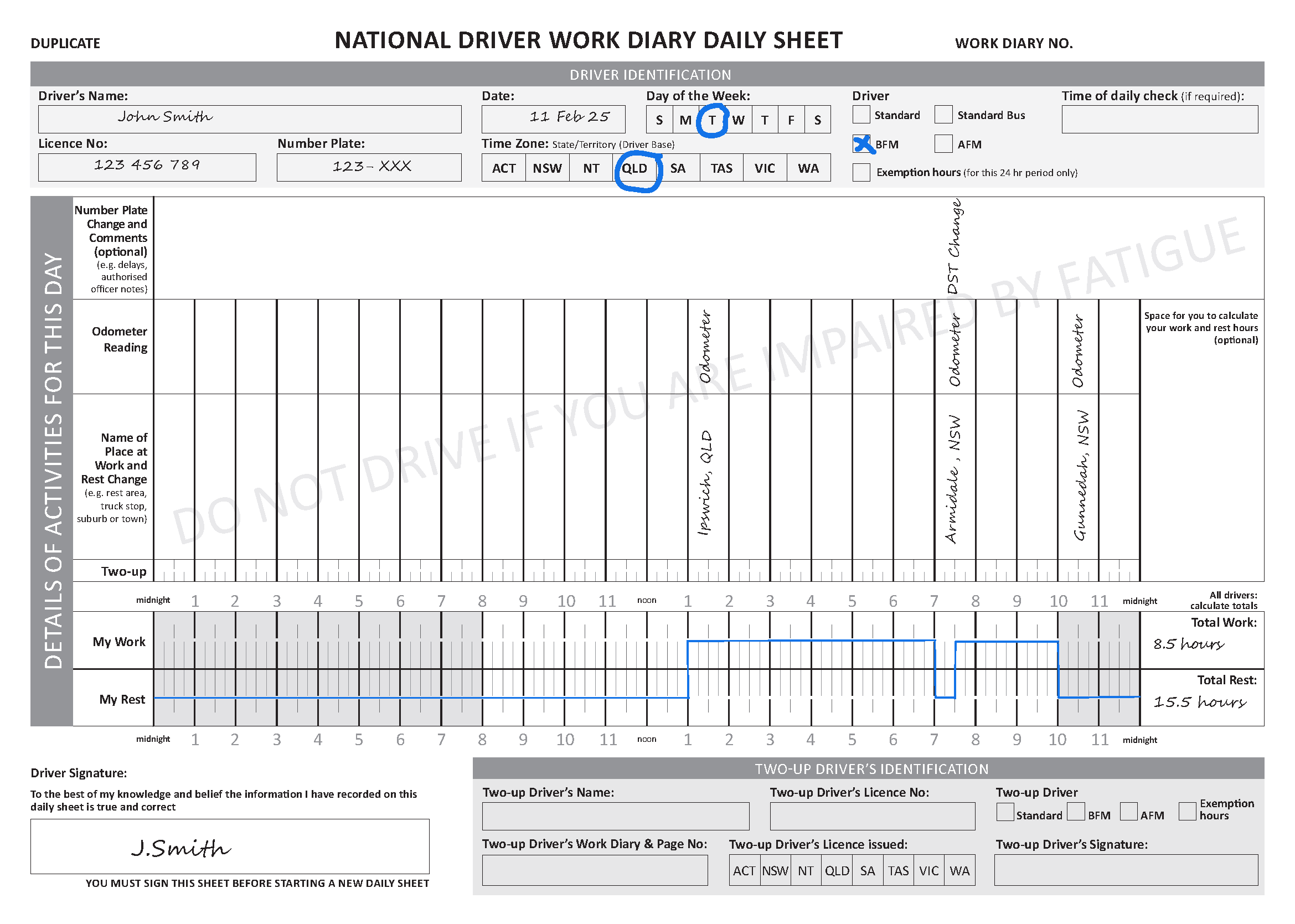
Example 5: Work Diary showing recorded entry for two-up driving from Queensland to New South Wales during DST
Example 5: Two up drivers on standard time driving from Queensland to New South Wales.
- Rohan and Dan are two up drivers working under standard hours. They are completing a round trip from Maroochydore, Queensland to North Sydney New South Wales during DST in New South Wales. Their base time is Queensland time.
- Rohan begins his work time at 4am and records 5 hours work time to 9am (base time) where he takes a 2-hour rest break in the sleeper berth.
- Dan rests from 4am in the sleeper berth and commences driving from 9:15am base (Queensland time) and drives 5.25 hours. He records his next rest at 2:30pm base (Queensland time).
- Rohan sits in the passenger seat from 11am base time, and begins driving at 2:30pm to drive the final 30 minutes to North Sydney, where the time is 4pm (New South Wales time).
- Rohan will record 4 hours work time as 11am (base time) to 3pm (base time).
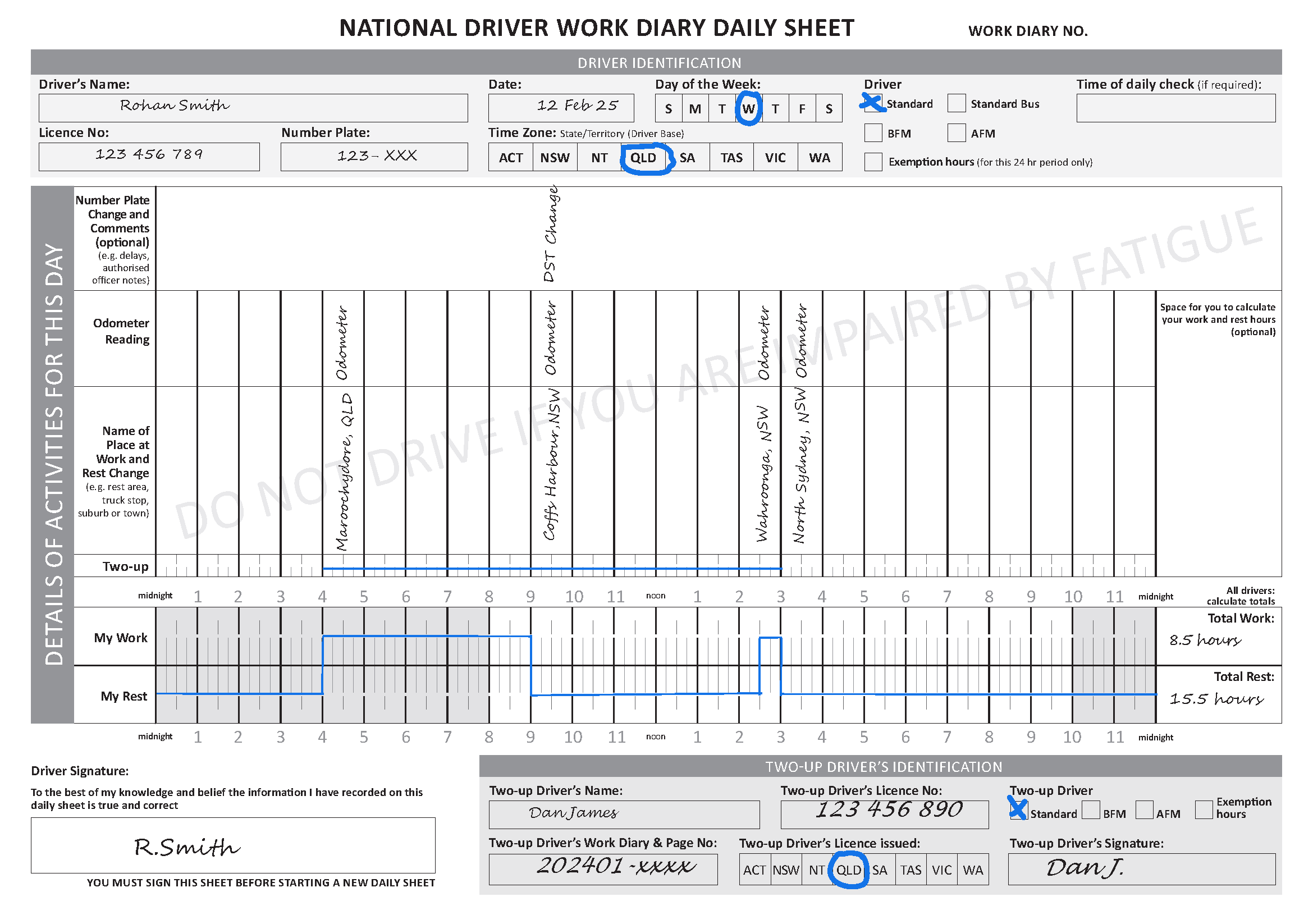

For more information, please see Work and rest requirements.
Tip: If you’re driving near the Queensland/New South Wales border, your smartphone may show the wrong time zone. If you can, adjust your phone’s settings to avoid automatic time zone changes to avoid confusion.
Electronic Work Diaries
- If you are using an Electronic Work Diary (EWD), it will automatically adjust according to your base time entered.
- Record keepers must check that any EWD records and reports are showing correct home base time zone
- It is advisable to make a note in your comments section to identify the time change for DST.
For more information, please see Electronic Work Diary.
Important information on rest time and night rests in changing time zones
- Drivers travelling outside their normal time zone should ensure that they schedule their night rests according to the time zone of their base.
- BFM hours solo drivers must calculate ‘long and night hours’ according to the time zone of their base.

 Accessibility tools
Accessibility tools

